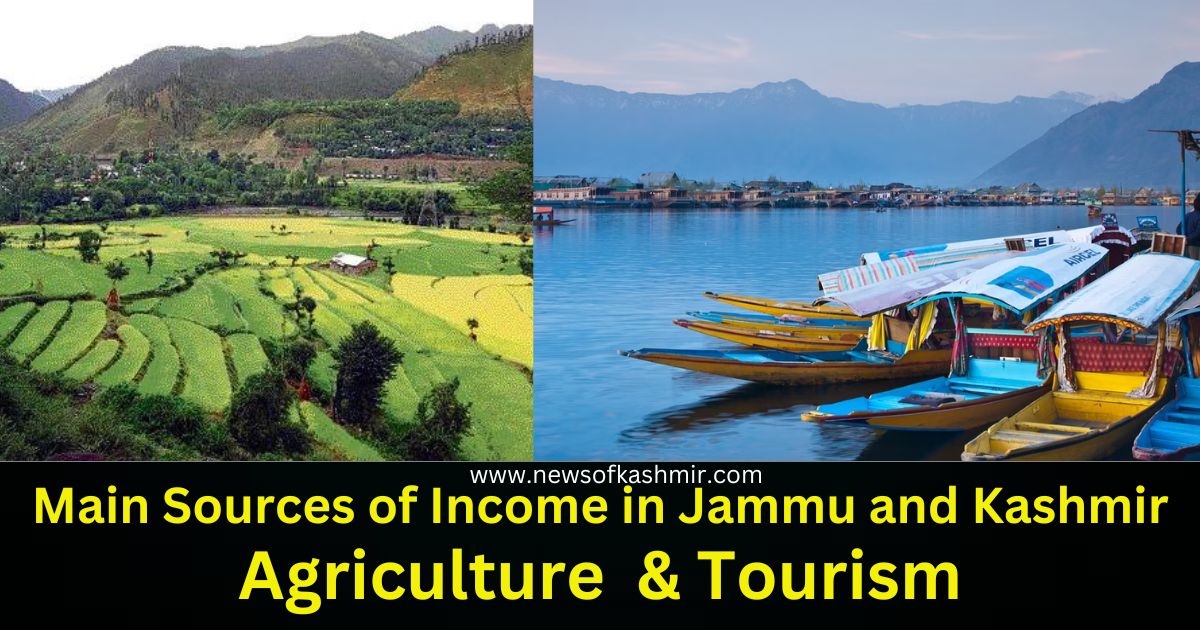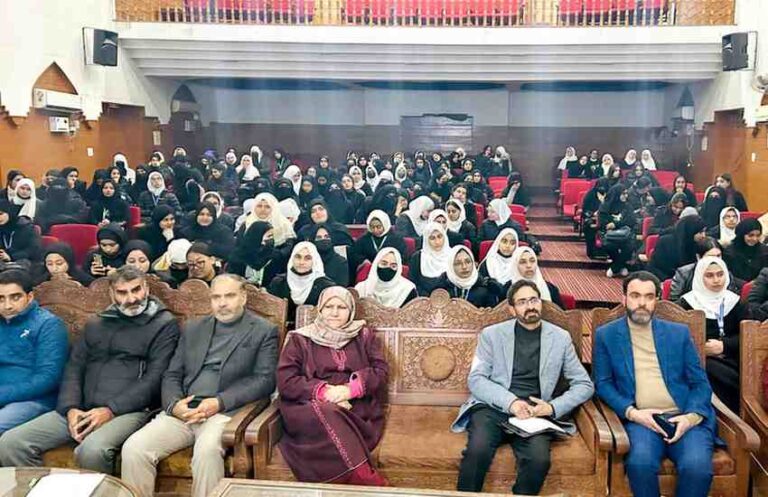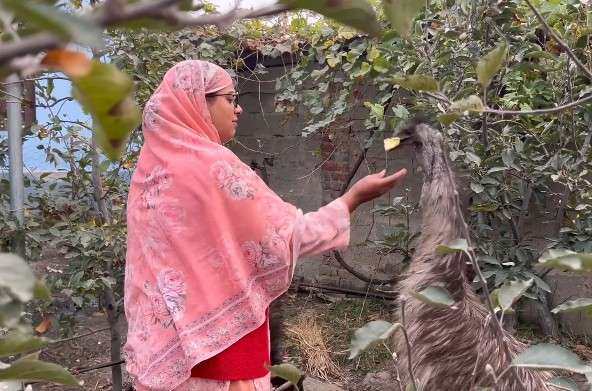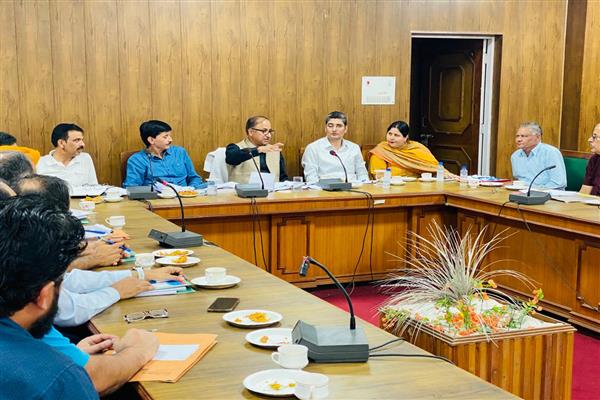Exploring the Main Sources of Income in Jammu and Kashmir: Agriculture, Tourism, Handicrafts, and Government Employment

Jammu and Kashmir, located in the northern part of India, is known for its spectacular landscapes and rich cultural heritage. From its snow-capped mountains to its lush valleys, the region’s natural beauty is unparalleled. Yet, beyond its picturesque scenery, Jammu and Kashmir’s economy is supported by a diverse range of sectors. In this article, we’ll delve into the main sources of income in this unique region: agriculture, tourism, handicrafts, and government employment.
Agriculture: The Backbone of Rural Economy
Agriculture has long been the backbone of Jammu and Kashmir’s economy, sustaining a large part of the population. The region’s diverse topography and varied climatic conditions create an environment conducive to the cultivation of a wide range of crops.
Crops and Farming Practices
In the Jammu region, agriculture is characterised by the cultivation of staple crops such as wheat, rice, and maize. The fertile alluvial soil in the plains of Jammu supports the cultivation of these staple crops, which are essential for local food security. Farmers in this region use traditional methods alongside modern techniques to optimise crop yields.
In the Kashmir Valley, the focus shifts to high-value crops. The valley is renowned for its saffron, which is one of the most expensive spices in the world. The unique climate and soil conditions in regions like Pampore provide the ideal conditions for saffron cultivation. The spice’s delicate flowers are harvested by hand, and the process is both labour-intensive and time-consuming.
Horticulture: A Fruitful Industry
Horticulture also plays a crucial role in the agricultural sector. The Kashmir Valley is famous for its apple orchards, which produce a variety of apple types, including the renowned Kashmiri apple. Apples from this region are known for their crispness and sweetness, making them highly sought after in domestic and international markets.
In addition to apples, other fruits such as cherries, apricots, walnuts, and almonds are grown in the region. The cultivation of these fruits not only supports local farmers but also contributes significantly to the region’s economy through exports.
Challenges and Future Prospects
Despite its importance, agriculture in Jammu and Kashmir faces several challenges. Issues such as inadequate irrigation facilities, land degradation, and the impact of climate change pose threats to agricultural productivity. The region is also prone to natural disasters such as floods and landslides, which can damage crops and disrupt farming activities.
Efforts are being made to address these challenges through various government schemes and initiatives aimed at improving irrigation infrastructure, introducing modern farming techniques, and providing financial support to farmers. The focus is also on promoting organic farming and increasing the value of agricultural products through better marketing strategies.
Tourism: The Jewel of Jammu and Kashmir’s Economy
Tourism is another major source of income for Jammu and Kashmir. The region’s stunning natural beauty and rich cultural heritage make it a popular destination for tourists from around the world.
Natural Attractions
Jammu and Kashmir is blessed with a range of natural attractions that draw tourists year-round. The snow-capped peaks of the Himalayas, particularly in areas like Gulmarg and Pahalgam, offer excellent opportunities for skiing and trekking. The picturesque Dal Lake and Nigeen Lake in Srinagar, with their traditional houseboats and shikaras (wooden boats), provide a unique experience for visitors seeking tranquillity and scenic beauty.
The region’s lush green meadows, such as those in Sonamarg, and the pristine environment of the Dachigam National Park, home to the endangered Hangul deer, are also significant draws for nature enthusiasts.
Cultural and Historical Significance
In addition to its natural beauty, Jammu and Kashmir has a rich cultural and historical heritage. The region is home to several ancient temples, such as the Vaishno Devi Temple in Katra, which attracts millions of pilgrims each year. The Mughal gardens of Srinagar, including Shalimar Bagh and Nishat Bagh, are renowned for their architectural beauty and historical significance.
Traditional Kashmiri crafts, including carpets, shawls, and paper-mâché items, are also a part of the cultural tourism experience. Visitors often purchase these items as souvenirs, which supports local artisans and contributes to the region’s economy.
Challenges and Tourism Development
Tourism in Jammu and Kashmir has faced its share of challenges, including political instability and security concerns. However, the government and local authorities are continuously working to promote the region as a safe and attractive tourist destination. Efforts are being made to improve infrastructure, enhance safety measures, and offer a range of activities that cater to different types of travellers.
The development of eco-tourism and sustainable tourism practices is also a priority. By promoting responsible tourism, the region aims to protect its natural resources while providing economic benefits to local communities.
Handicrafts: Preserving Tradition and Generating Income
Jammu and Kashmir is renowned for its traditional handicrafts, which are an important source of income for many families. The region’s rich cultural heritage is reflected in its crafts, which are celebrated for their intricate designs and high-quality craftsmanship.
Notable Handicrafts
One of the most famous handicrafts from the region is the Kashmiri shawl. These shawls are made from fine wool or silk and are often embroidered with elaborate patterns. The artistry involved in creating these shawls is passed down through generations, and they are highly valued both domestically and internationally.
Kashmiri carpets are another renowned product, known for their intricate designs and high quality. The weaving of these carpets is a time-honoured tradition, and each piece is often handcrafted with great skill and precision.
Paper-mâché items from the region are also popular. These items, which include decorative boxes, trays, and figurines, are made using a traditional technique that involves layering paper and applying intricate designs.
Economic Impact and Challenges
Handicrafts contribute significantly to the region’s economy by providing employment to artisans and supporting local businesses. However, the sector faces challenges such as competition from mass-produced items and fluctuating market conditions. The decline in traditional craftsmanship skills due to the younger generation’s migration to urban areas for better opportunities also poses a challenge.
To support the handicrafts industry, efforts are being made to promote these products through exhibitions and fairs, both within India and abroad. There is also a focus on modernising traditional techniques and exploring new markets to sustain the industry’s growth.
Government Employment: A Stable Source of Income
Government employment is a significant source of income for many residents of Jammu and Kashmir. The public sector provides jobs in various fields, including administration, education, and health services.
Public Sector Jobs
In Jammu and Kashmir, the government is a major employer, with many people working in administrative roles at various levels. This includes positions in local, state, and central government offices, as well as public sector enterprises.
Educational institutions, including schools and universities, are another major source of employment. Teachers and administrative staff in these institutions are employed by the government, contributing to job stability and providing a steady income for many families.
The health sector, including hospitals and clinics, also offers employment opportunities. Medical professionals, including doctors, nurses, and support staff, are employed by government health facilities, ensuring that the population has access to medical services.
Challenges and Opportunities
Government employment provides job security and benefits, but it also faces challenges such as bureaucratic inefficiencies and limited opportunities for career advancement. The region is also grappling with issues related to recruitment and the need for modernisation in various public sector departments.
To address these challenges, there is a focus on improving administrative processes, enhancing training and development programs, and exploring opportunities for public-private partnerships. These efforts aim to create a more efficient and dynamic public sector that can better serve the needs of the region’s residents.
Conclusion
Jammu and Kashmir’s economy is supported by a diverse range of sectors, each contributing to the region’s financial health and stability. Agriculture remains a vital source of income, with the cultivation of staple crops and high-value produce such as saffron and apples. Tourism, with its natural attractions and cultural heritage, draws visitors from around the world and provides significant economic benefits. Handicrafts, reflecting the region’s rich traditions, support local artisans and contribute to the economy. Government employment offers stability and security to many residents.
Despite the challenges faced by each sector, ongoing efforts to address issues and promote sustainable growth are crucial for the region’s economic development. By balancing traditional strengths with modern advancements, Jammu and Kashmir can continue to thrive and offer opportunities for its people while preserving its unique cultural and natural heritage.
The Revenue of Tourism in Kashmir: An Overview
Tourism is a major source of income for Kashmir, known for its stunning scenery and cultural richness. However, understanding how much revenue tourism brings in can be a bit complex, as figures can change from year to year. Here’s a simple overview of tourism revenue in Kashmir, including recent trends and future prospects.
How Much Money Does Tourism Bring in?
Historical Figures
Before the COVID-19 pandemic, tourism in Kashmir was a big contributor to the region’s economy. In the year 2018-2019, tourism brought in around ₹8,000-10,000 crore (about $1 billion – $1.3 billion). This revenue came from visitors both from India and abroad who enjoyed the beautiful landscapes, historical sites, and cultural experiences that Kashmir has to offer.
Impact of COVID-19
The pandemic had a huge impact on tourism globally, including in Kashmir. Travel restrictions and lockdowns meant that fewer tourists could visit, causing a significant drop in revenue. In 2020 and 2021, tourism revenue in Kashmir fell by roughly 70% compared to the years before the pandemic.
Recent Recovery
As the world began to recover from the pandemic, so did Kashmir’s tourism sector. By the end of 2023, tourism revenue in Kashmir was estimated to be recovering, though not quite back to pre-pandemic levels. The revenue during this period was around ₹5,000-7,000 crore (approximately $600 million – $900 million). The increase in visitors and spending has been encouraging, but the industry is still working to fully bounce back.
What Contributes to Tourism Revenue?
- Accommodation and Hospitality: Hotels, guesthouses, and houseboats are major sources of income. Places like Srinagar are well-known for their beautiful houseboats and luxury hotels, which attract many tourists.
- Transport and Travel Services: Revenue also comes from transportation services such as taxis, shikaras (traditional boats), and tour operators. The transport infrastructure, including roads and airports, helps facilitate tourism.
- Local Crafts and Souvenirs: Kashmir is famous for its handicrafts, such as shawls, carpets, and paper-mâché items. Tourists often buy these items as souvenirs, which supports local artisans and contributes to tourism revenue.
- Recreational Activities: Activities like skiing in Gulmarg, trekking, and other adventure sports are popular among tourists. These activities generate additional income and support local businesses.
Looking Ahead: Future Prospects
To boost tourism revenue in the future, the government and local authorities are focusing on several key areas:
- Improving Infrastructure: Upgrading roads, airports, and accommodation facilities to make the region more accessible and comfortable for tourists.
- Diversifying Tourism Options: Promoting different types of tourism, such as eco-tourism and cultural tourism, to attract a wider range of visitors.
- Marketing and Promotion: Increasing efforts to market Kashmir’s attractions through various channels, including online platforms and travel fairs.
- Sustainable Tourism: Implementing practices that protect the environment and preserve cultural heritage while ensuring that local communities benefit from tourism.
Conclusion
Tourism is a vital part of Kashmir’s economy, bringing in significant revenue and supporting many local businesses. Although the sector was hit hard by the COVID-19 pandemic, there are signs of recovery as more tourists return. By continuing to improve infrastructure, diversify tourism offerings, and promote the region, Kashmir aims to enhance its tourism revenue and ensure long-term growth.





